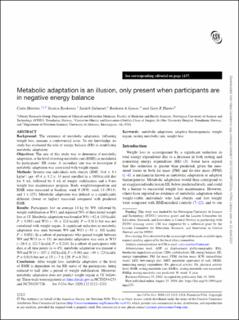| dc.description.abstract | Background
The existence of metabolic adaptation, following weight loss, remains a controversial issue. To our knowledge, no study has evaluated the role of energy balance (EB) in modulating metabolic adaptation.
Objectives
The aim of this study was to determine if metabolic adaptation, at the level of resting metabolic rate (RMR), is modulated by participants’ EB status. A secondary aim was to investigate if metabolic adaptation was associated with weight regain.
Methods
Seventy-one individuals with obesity (BMI: 34.6 ± 3.4 kg/m2; age: 45.4 ± 8.2 y; 33 men) enrolled in a 1000-kcal/d diet for 8 wk, followed by 4 wk of weight stabilization and a 9-mo weight loss maintenance program. Body weight/composition and RMR were measured at baseline, week 9 (W9), week 13 (W13), and 1 y (1Y). Metabolic adaptation was defined as a significantly different (lower or higher) measured compared with predicted RMR.
Results
Participants lost on average 14 kg by W9, followed by weight stabilization at W13, and regained 29% of their initial weight loss at 1Y. Metabolic adaptation was found at W9 (−92 ± 110 kcal/d, P < 0.001) and W13 (−38 ± 124 kcal/d, P = 0.011) but was not correlated with weight regain. A significant reduction in metabolic adaptation was seen between W9 and W13 (−53 ± 101 kcal/d, P < 0.001). In a subset of participants who gained weight between W9 and W13 (n = 33), no metabolic adaptation was seen at W13 (−26.8 ± 121.5 kcal/d, P = 0.214). In a subset of participants with data at all time points (n = 45), metabolic adaptation was present at W9 and W13 (−107 ± 102 kcal/d, P < 0.001 and −49 ± 128 kcal/d, P = 0.013) but not at 1Y (−7 ± 129, P = 0.701).
Conclusion
After weight loss, metabolic adaptation at the level of RMR is dependent on the EB status of the participants, being reduced to half after a period of weight stabilization. Moreover, metabolic adaptation does not predict weight regain at 1Y follow-up. These trials were registered at clinicaltrials.gov as NCT02944253 and NCT03287726. | en_US |

